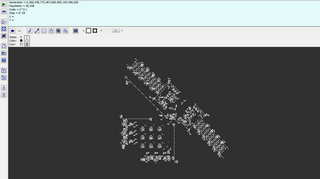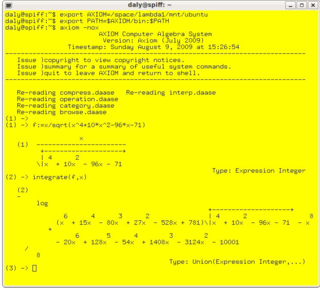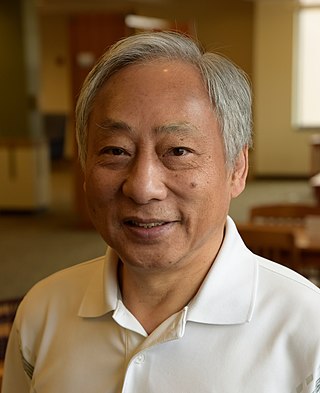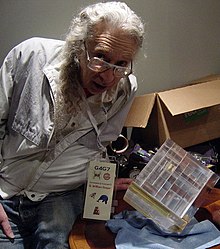The number π is a mathematical constant that is the ratio of a circle's circumference to its diameter, approximately equal to 3.14159. The number π appears in many formulae across mathematics and physics. It is an irrational number, meaning that it cannot be expressed exactly as a ratio of two integers, although fractions such as are commonly used to approximate it. Consequently, its decimal representation never ends, nor enters a permanently repeating pattern. It is a transcendental number, meaning that it cannot be a solution of an equation involving only sums, products, powers, and integers. The transcendence of π implies that it is impossible to solve the ancient challenge of squaring the circle with a compass and straightedge. The decimal digits of π appear to be randomly distributed, but no proof of this conjecture has been found.

The Game of Life, also known simply as Life, is a cellular automaton devised by the British mathematician John Horton Conway in 1970. It is a zero-player game, meaning that its evolution is determined by its initial state, requiring no further input. One interacts with the Game of Life by creating an initial configuration and observing how it evolves. It is Turing complete and can simulate a universal constructor or any other Turing machine.

The Koch snowflake is a fractal curve and one of the earliest fractals to have been described. It is based on the Koch curve, which appeared in a 1904 paper titled "On a Continuous Curve Without Tangents, Constructible from Elementary Geometry" by the Swedish mathematician Helge von Koch.
A computer algebra system (CAS) or symbolic algebra system (SAS) is any mathematical software with the ability to manipulate mathematical expressions in a way similar to the traditional manual computations of mathematicians and scientists. The development of the computer algebra systems in the second half of the 20th century is part of the discipline of "computer algebra" or "symbolic computation", which has spurred work in algorithms over mathematical objects such as polynomials.
Experimental mathematics is an approach to mathematics in which computation is used to investigate mathematical objects and identify properties and patterns. It has been defined as "that branch of mathematics that concerns itself ultimately with the codification and transmission of insights within the mathematical community through the use of experimental exploration of conjectures and more informal beliefs and a careful analysis of the data acquired in this pursuit."
In symbolic computation, the Risch algorithm is a method of indefinite integration used in some computer algebra systems to find antiderivatives. It is named after the American mathematician Robert Henry Risch, a specialist in computer algebra who developed it in 1968.
Macsyma is one of the oldest general-purpose computer algebra systems still in wide use. It was originally developed from 1968 to 1982 at MIT's Project MAC.
Axiom is a free, general-purpose computer algebra system. It consists of an interpreter environment, a compiler and a library, which defines a strongly typed hierarchy.
HAKMEM, alternatively known as AI Memo 239, is a February 1972 "memo" of the MIT AI Lab containing a wide variety of hacks, including useful and clever algorithms for mathematical computation, some number theory and schematic diagrams for hardware – in Guy L. Steele's words, "a bizarre and eclectic potpourri of technical trivia". Contributors included about two dozen members and associates of the AI Lab. The title of the report is short for "hacks memo", abbreviated to six upper case characters that would fit in a single PDP-10 machine word.

Hashlife is a memoized algorithm for computing the long-term fate of a given starting configuration in Conway's Game of Life and related cellular automata, much more quickly than would be possible using alternative algorithms that simulate each time step of each cell of the automaton. The algorithm was first described by Bill Gosper in the early 1980s while he was engaged in research at the Xerox Palo Alto Research Center. Hashlife was originally implemented on Symbolics Lisp machines with the aid of the Flavors extension.
In calculus, symbolic integration is the problem of finding a formula for the antiderivative, or indefinite integral, of a given function f(x), i.e. to find a differentiable function F(x) such that
Joel Moses was an Israeli-American mathematician, computer scientist, and Institute Professor at the Massachusetts Institute of Technology (MIT).

Approximations for the mathematical constant pi in the history of mathematics reached an accuracy within 0.04% of the true value before the beginning of the Common Era. In Chinese mathematics, this was improved to approximations correct to what corresponds to about seven decimal digits by the 5th century.
Symbolic Manipulation Program, usually called SMP, was a computer algebra system designed by Chris A. Cole and Stephen Wolfram at Caltech circa 1979. It was initially developed in the Caltech physics department with contributions from Geoffrey C. Fox, Jeffrey M. Greif, Eric D. Mjolsness, Larry J. Romans, Timothy Shaw, and Anthony E. Terrano.

Stephen Malvern Omohundro is an American computer scientist whose areas of research include Hamiltonian physics, dynamical systems, programming languages, machine learning, machine vision, and the social implications of artificial intelligence. His current work uses rational economics to develop safe and beneficial intelligent technologies for better collaborative modeling, understanding, innovation, and decision making.
Paterson's worms are a family of cellular automata devised in 1971 by Mike Paterson and John Horton Conway to model the behaviour and feeding patterns of certain prehistoric worms. In the model, a worm moves between points on a triangular grid along line segments, representing food. Its turnings are determined by the configuration of eaten and uneaten line segments adjacent to the point at which the worm currently is. Despite being governed by simple rules the behaviour of the worms can be extremely complex, and the ultimate fate of one variant is still unknown.
In mathematics, Gosper's algorithm, due to Bill Gosper, is a procedure for finding sums of hypergeometric terms that are themselves hypergeometric terms. That is: suppose one has a(1) + ... + a(n) = S(n) − S(0), where S(n) is a hypergeometric term (i.e., S(n + 1)/S(n) is a rational function of n); then necessarily a(n) is itself a hypergeometric term, and given the formula for a(n) Gosper's algorithm finds that for S(n).

In mathematics and computer science, computer algebra, also called symbolic computation or algebraic computation, is a scientific area that refers to the study and development of algorithms and software for manipulating mathematical expressions and other mathematical objects. Although computer algebra could be considered a subfield of scientific computing, they are generally considered as distinct fields because scientific computing is usually based on numerical computation with approximate floating point numbers, while symbolic computation emphasizes exact computation with expressions containing variables that have no given value and are manipulated as symbols.

The Wolfram Language is a proprietary, general high-level multi-paradigm programming language developed by Wolfram Research. It emphasizes symbolic computation, functional programming, and rule-based programming and can employ arbitrary structures and data. It is the programming language of the mathematical symbolic computation program Mathematica.

Paul S. Wang is a Chinese-American computer scientist, researcher, author, consultant, and academic. He is Professor Emeritus of Computer Science at Kent State University.








